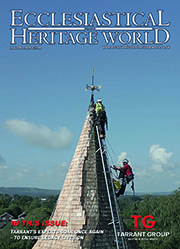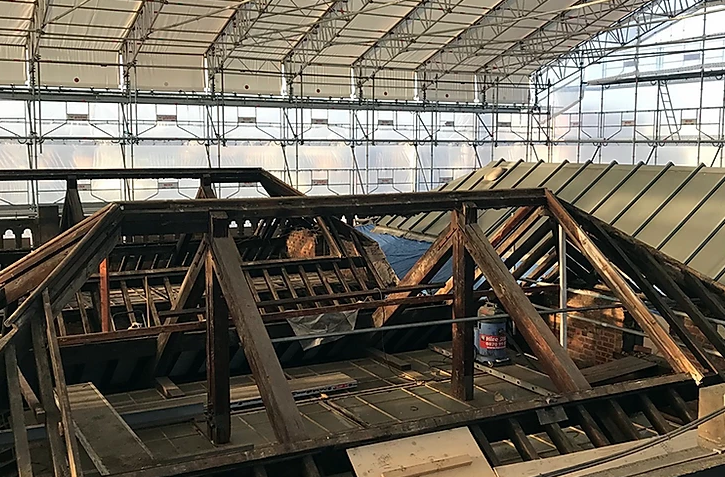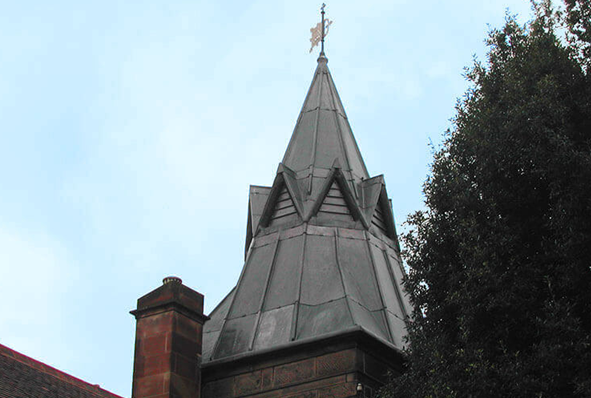Heritage Roofing
Heritage roofing - maintaining our iconic buildings
The UK is home to some of the most iconic buildings in the world, from stunning churches and cathedrals to historic stately homes. Each and every one of these remarkable feats of architecture requires regular maintenance to ensure they remain in the very best condition, allowing them to be enjoyed for generations.
Lightning Protection
When lightning strikes are you protected against this act of God?
The issue of lightning protection in churches is one that has exercised this publication for many years. In this four-part series of spotlights on the issue we will be revisiting various aspects of the subject, beginning with an overview of current thinking.
Traditional Lime
Lime: it’s better for buildings – and for the environment
It is now fairly well known that cement is not good for old buildings and that lime mortar should be used. But why? What are the advantages and what are the disadvantages? In order to begin to answer those questions it is necessary to understand the nature of traditional building, the process by which buildings used to be built, and how it differs from modern construction, the process by which we build today.
Audio Visual
Audio visual equipment in church buildings
This guidance is issued by the Church Buildings Council under section 55(1)(d) of the Dioceses, Mission and Pastoral Measure 2007. As it is statutory guidance, it must be considered with great care. The standards of good practice set out in the guidance should not be departed from unless the departure is justified by reasons that are spelled out clearly, logically and convincingly.
Read More...
CRE Events
Churches are coming under starter’s orders for CRE 25
Churches across the nation are beginning to make preparations for their visit to Christian Resources Exhibition’s CRE 25.
Insurance
You need to ensure that reasonable precautions are in place at your church to keep it safe for those who use it. To do this, you need to think about what might cause harm to people.
You will then need to decide if the precautions already in place are adequate. If they are not, you may need to identify further action to prevent any danger. When done formally, this is known as a risk assessment.
LPOW Grants
£23 million government package to support restoration of thousands of listed places of worship
Heritage Minister Sir Chris Bryant has announced that the Listed Places of Worship Grant Scheme will be extended into the next financial year, providing £23 million so that thousands of historical buildings, including churches, synagogues, mosques and temples, can carry out restoration work.
Lead Roofing
Lead is one of the oldest materials in the roofing industry and is still commonly used throughout the world today.
Lead roofing is a traditional roofing method which has been used in the industry for hundreds of years, and is therefore proven to be extremely reliable. Lead roofing, and sand-cast lead, in particular is ideal for old buildings such as churches or historical renovations, whereas milled lead roofing is a mass-produced alternative, used for precision and accuracy in homes and commercial buildings alike.
Home
LAFARGE’S BIODIVERSITY COMMITMENT HAILED AS ‘BEACON FOR OTHER BUSINESSES’
LAFARGE’S commitment to habitat restoration has been applauded by leading biodiversity champions.
Eminent environmentalists, experts and scientists, along with government officials and commercial leaders, acclaimed the company’s biodiversity initiatives as ‘an important beacon for other businesses’.
The support came following a visit to Panshanger Park, Hertfordshire, on the eve of GBOB, the first ever Global Business of Biodiversity Symposium.
Attracting delegates from around the world the Symposium sought to celebrate the UN’s International Year of Biodiversity, recognise existing work and provide a forum for the exchange of knowledge and expertise.
As co-sponsor of the symposium Lafarge Aggregates and Concrete UK were invited to host the pre-event enabling delegates to gain an insight into the company’s pioneering quarry rehabilitation projects.
Delegates were taken on a guided tour of the Panshanger site which comprises more than 400ha of Grade II* listed parkland originally designed by Humphrey Repton with remnants of Capability Brown landscaping.
Here they were able to see at first hand, an example of industry working with environmental partners to create new and important habitats.
Following their visit almost all considered that Lafarge’s biodiversity initiatives served as an important beacon for other businesses.
Over 80 per cent of delegates indicated the event had raised their awareness of Lafarge’s commitment to biodiversity and the determination of the company in making a real contribution to halting the loss of biodiversity.
David Park, Lafarge A&C UK Regional Restoration Manager (North), said:
“We are proud the work we have done at Panshanger has been recognised by some of the world’s most eminent environmental experts and stakeholders. Our commitment to restoration and sustainability underpins our operations and while quarrying and construction may seem poles apart from nature conservation, at Lafarge this is certainly not true.”
“We take our environmental responsibility very seriously and we invest much time, effort and dedicated resources into making a lasting contribution to enhancing biodiversity.”
More than half of the delegates thought that reduction in habitats was the main driver behind the loss of biodiversity globally.
Crucially habitat creation, carried out as part of the sympathetic restoration of its sites, provides Lafarge with a real opportunity to contribute towards halting the loss of biodiversity, not only in the UK but throughout its operations worldwide.
The habitats found on the restored areas at Panshanger only exist as a consequence of Lafarge gaining permission to extract sand and gravel from the site.
Other valuable habitat on site, are managed in accordance with a management plan, drawn up as part of the mineral extraction planning permission.
Richard Millican, Regional Restoration Manager, who is heavily involved in the restoration at Panshanger, said:
“Without the quarry it's doubtful if much of the work would be taking place, and the new habitat would not have been created. The huge range of biodiversity across the site is one of Panshanger Estate’s unique features and a measure of the success of the site’s restoration and management.
“This is evident in the range and diversity of mammals, birds, invertebrates and other species recorded and observed at the Panshanger Estate.”
Lafarge operates in partnership with wildlife trusts, national conservation organisations and local community groups.
And as well as employing expert in-house restoration specialists the business works closely with established naturalists and ornithologists.
Notes to editors
Lafarge Aggregates
- The Lafarge Group is the world leader in building materials, with top-ranking positions in all of its businesses: Cement, Aggregates & Concrete and Gypsum.
- Lafarge A&C UK is part of the world's largest building materials group and is a major UK supplier of innovative concretes and asphalts, rock, sand and gravel and waste management services. Lafarge A&C UK is proud of its hands-on approach to sustainability, which includes award-winning quarry restoration, the careful management of two National Nature Reserves and the development of sustainable, low-energy homes. Innovation and architectural creativity are at the heart of Lafarge's priorities and in 2010, for the sixth year in a row, Lafarge was listed in the ‘Global 100 Most Sustainable Corporations in the World’.
- For additional information, or interview or photo’ requests, please contact Karen Almond, Media Relations Officer on 07972 533724 or by email at This email address is being protected from spambots. You need JavaScript enabled to view it.. Alternatively please find further information on the web site at
- Find ‘Lafarge UK’ on Facebook.
* Source: Corporate Knights Inc. www.global100.com




















